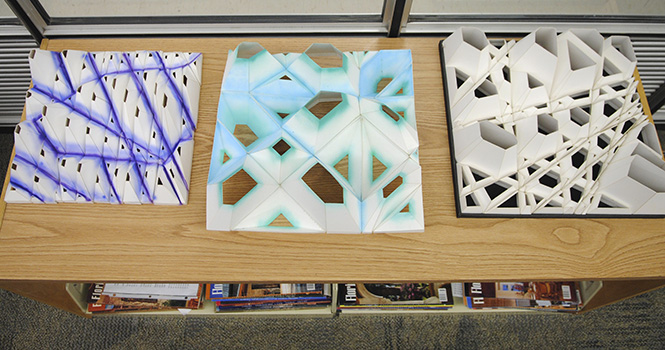Unique design process offers challenges for architecture students
A workshop titled “Organized Crime” was held for students, faculty and alumni of the architecture department recently, where participants created 3D designs. The designs and step by step process posters are hanging in the architecture library in Taylor Hall. Photo by Jenna Watson.
November 29, 2012
A square-grid pattern, a design that looks like a spirograph, some geometric shapes and shaded figures that look like mountains are hanging along the wall of the Architecture Library in Taylor Hall.
The posters are a result of a weekend-long workshop called “Organized Crime,” in which students, faculty and alumni learned about parametric design by using Grasshopper, a graphic-programming software.
“We weren’t told what the end result would be,” said Ryan Grande, senior architecture major. “We just had to think about how to complete the small tasks [they gave us]. If I was told the end result, I would have altered the way I did things.”
Parametric design is a process where designers set rules for a project, rather than predetermining it.
The creator of the workshop, Kyle Miller, assistant architecture professor at the University of Kentucky, set up a template on the software and participants took what he started with and used the program to create geometric designs.
Participants first generated abstract designs using geometric shapes, then zoomed into a portion of the design. From there, the artists generated 3D images by instituting a set of parametric rules into the program. Users emphasized areas of the design with color to exaggerate the shapes.
Assistant professor Peter Marks, who organized the workshop, said participants were given no frame of reference and had little-to-no experience with the program.
“The intent of the workshop was to start from zero,” Marks said.
Participants were given outlined benchmarks to complete as they worked through the workshop.
Vivian Walker, senior architecture major, said she was expecting the workshop to be just a lecture and a short tutorial but was surprised they actually got to create designs.
“The first day was really difficult,” Walker said. “It’s a lot thrown at you at one time, but once you work through it, it was great.”
Carolyn Emmer, senior architecture major, said she found the workshop intimidating at first, but as she got more comfortable with the program, it was more manageable. She said the most difficult thing was she had to teach herself to think differently.
“I had to work backwards,” Emmer said. “I had to analyze the process of where I am and where I want to be [with the design].”
Marks gave the example of using the program in building design.
“For example, the design of an auditorium could be determined by creating a set of rules, reverberation time, views, etc. and then letting the tool determine different design iterations that satisfy those rules,” Marks said.
He also said that the designs in the workshop were determined by rules based on geometric relationships the designer sets, rather than by the designer’s preference.
“We don’t say what the product is going to be,” Marks said. “We tell [the program] the relationship, and it decides what it is going to be.”
Samuel Bender, senior architecture major, said he found the workshop very intense and the learning curve for the program set high.
“Even if you didn’t understand, you kept going,” Bender said. “I didn’t understand the program, but I understood the concepts.”
Overall, students said even though they spent more time than they planned at the workshop —sometimes staying until midnight to work with the program — they enjoyed it and would recommend it to other students.
“Architecture is all about who knows the latest program,” Walker said. “The more accurate you can develop a space, the better you will be in your career.”
Contact Kirsten Bowers at [email protected].
























